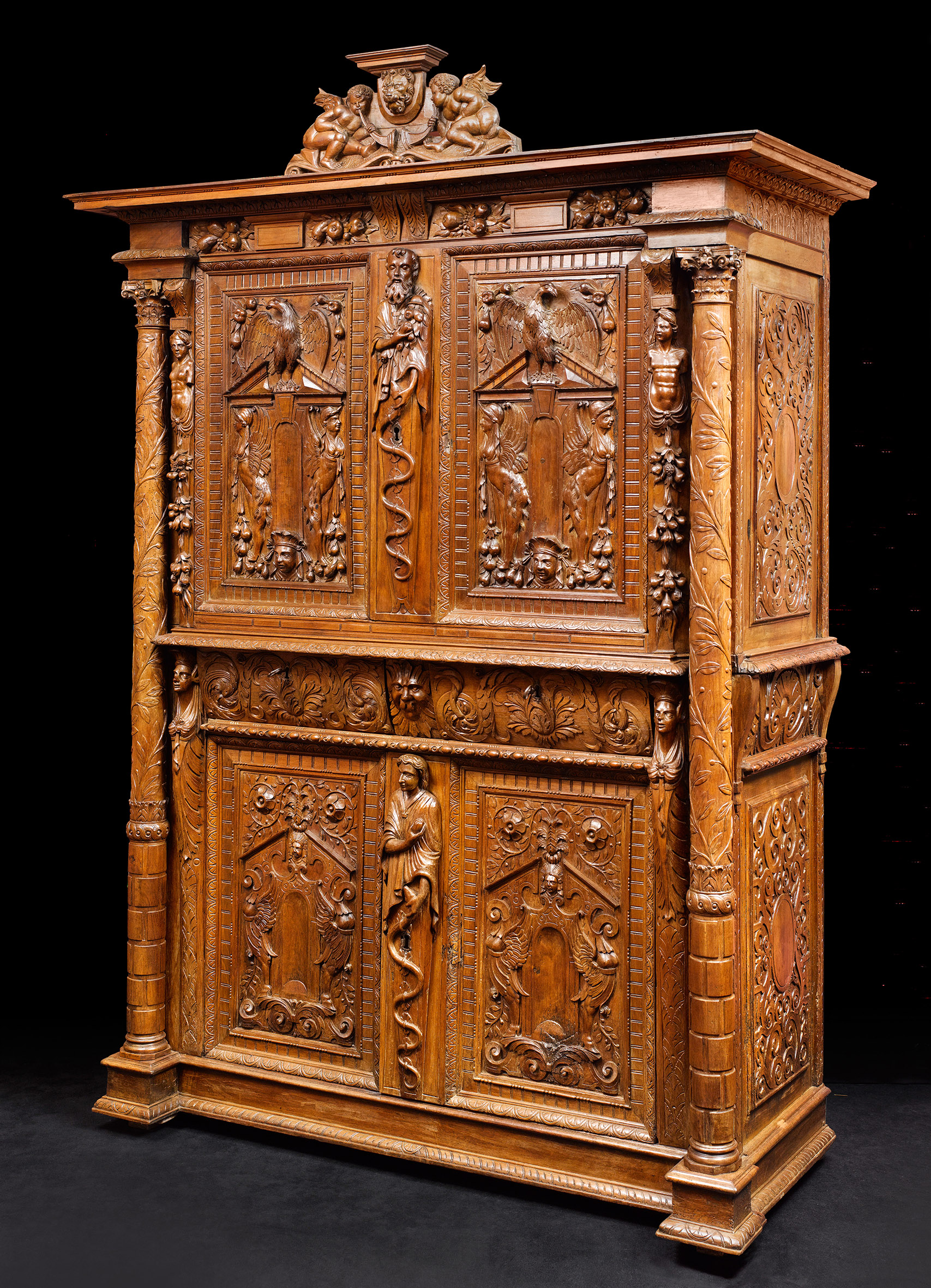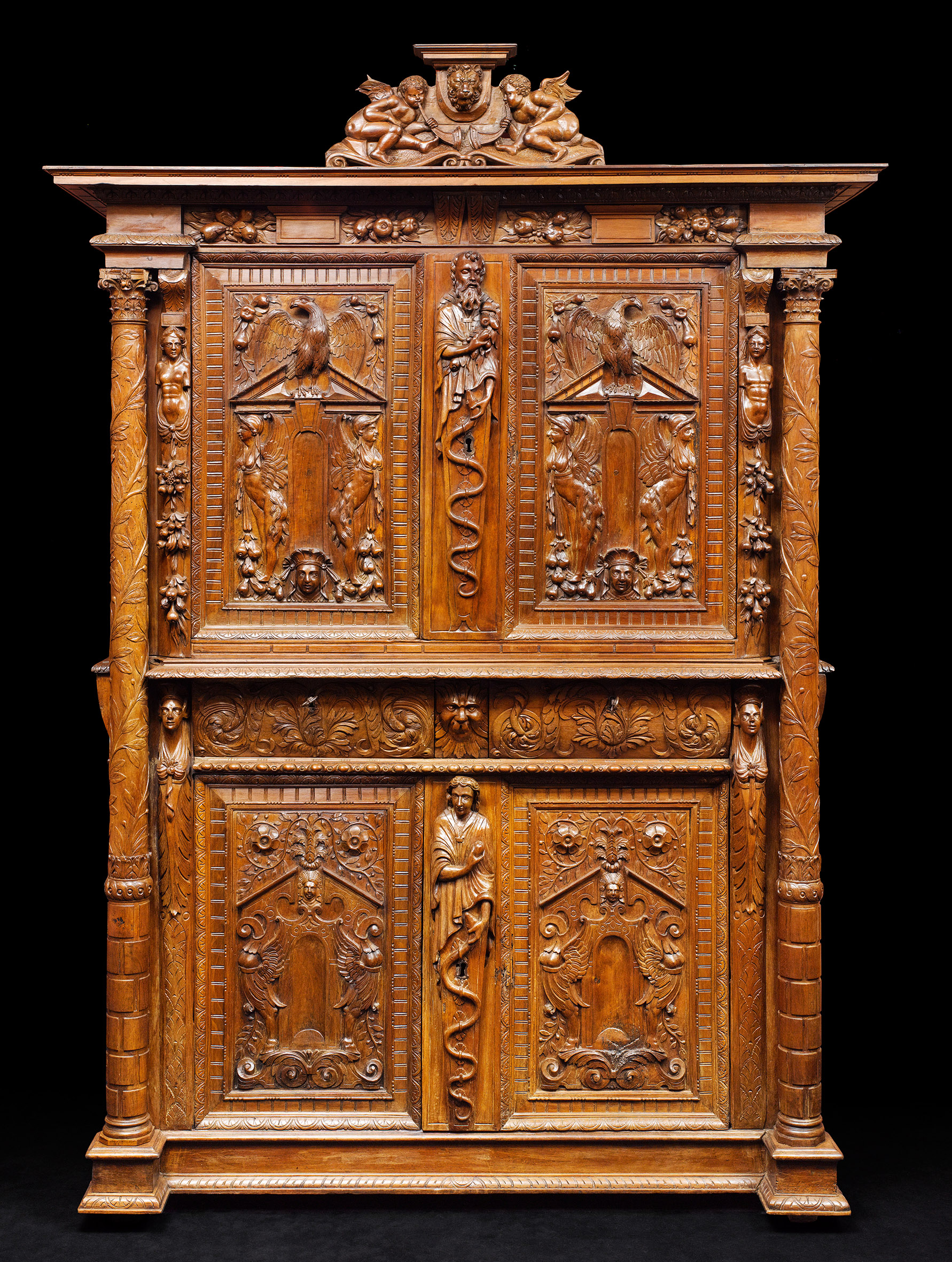Description
This two parts and two drawers cabinet is inspired by Hugues Sambin with his personages sculptures and also reflects the influence of Jacques Androuet du Cerceau by two monumental columns adorning its façade.
The upper part
Presenting a ternary scansion, three terms are interspacing the central carved panels. A female and male caryatid figures hanging with drapery are ending by three-swags river of fruits concealing the stiles. On the central one, a bearded old man is holding a bunch of fruits in his right hand and a undulating snake’s head with the other one.
The front door panels are richly carved and adorned with antic architectural designs, on the style of Renaissance spirit. They are framed by a double moulded frieze of semi-paterae patterns and a briquette one inside.
Each panel depicts a triangular broken pediment from where is raising a beautiful spreaded wings eagle, above a semicircular niche flanked by two winged chimeras resting on bunch of fruits. Fruits are applied on the spandrels too.
The entablature consists of an alternance of cartouches and swag of fruits, centred by a double leaf-cast corbel, sumonted by an acanthus frieze below the nicely molding ovehanging cornice.
On the top, the pediment depicts two winged putti sounding the trumpet flanking a Lion mask carved in hight-relief rising from a medallion supporting a step moulded cornice.
The lower part
To keep the ternary rhythm, the lower section is also scanded by three terms like on the upper part. It boasts on the waist two richly ornated drawers with a nice composition of scrolling acanthus leaves.
On the sides, terms hanging by drapery knotted on the bust, are coming out of quill-feather gains, followed by vegetal designs.
In the center, under the leonin mask, the third shorter term displays a young man dressed with a large pleated coat, holding a fruit on his right hand and a undulating snake’s head on the other one.
The carved doors present a different ornamentation. A central semicircular recess is flancked by two headless winged chimera figures. They are supporting a top of pediment with a laurel woman mask below an acanthus leaf extending in scrolling vegetal branches ending by an high-relief carved rosace.
On each side of the facade are rising two monumental freestanding columns adorned of scrolling laurel leaves on the upper part, briquette patterns on the lower one. In the middle, two friezes made of acanthus leaves above strapworks.
Coming from the base of the Cabinet, the columns raise toward the entablature ending by a Ionic capital.
The apron inserted between two mouldings is more strict on the style. Two projections on the extremities support the columns, concealing the feet of the Cabinet.
The sides
On the sides, a molded panel in centered by a boss surrounded by beautiful undulating foliage strapworks. Each one of them displays another ornate arrangement.
Thanks to the powerful sculpture of its columns and its drawers, this unusual piece of furniture has a strong presence.
Analogy
It is worth considering the similitude of design concerning the gain of term bodies on the lower section with the ones of the Cabinet displayed on the Cloture de la Chapelle du Saint Esprit au Palais de Justice de Dijon, the unique attested artwork executed by the hand of Hugues Sambin, with the porte du Scrin. On the gain, the superposed acanthus leaves is carved with a perfect stiffness and high quality of execution, similiar to the present Cabinet.
Bibliography
Les Cahiers du Musée National de la Renaissance, Hugues Sambin (vers 1520-1601), Réunion des Musées Nationaux, 2001.
New 2019 publication : Jean Pierre Jacquemart, Hugues Sambin, Architecteur, editions de la Passerelle, Dole, 2019. Some furnitures in the gallery illustrate this publication.


